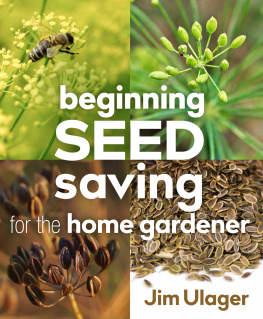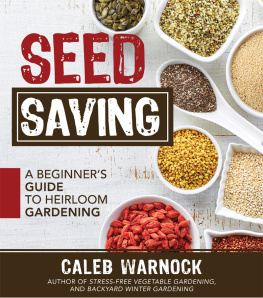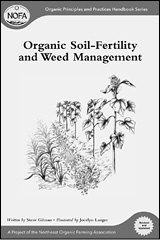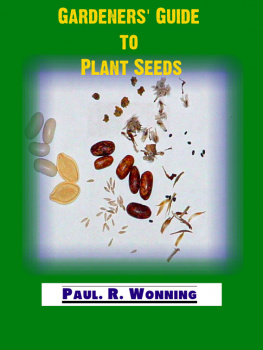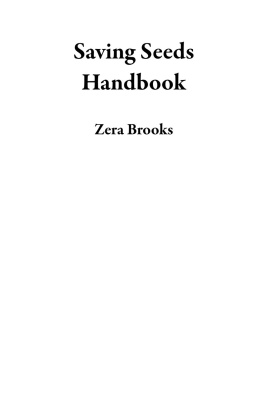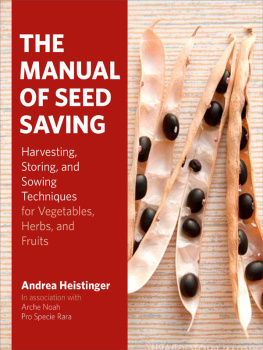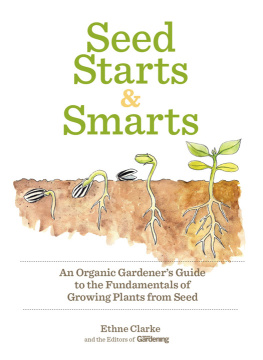Praise for
Beginning Seed Saving for the Home Gardener
My garden checklist hasnt included save seeds! for way too long. Why? I was waiting for someone to tackle the how and why of it in a way that made sense to me. For the first time in 30+ years, Im finally ready to take gardening to a whole new level. Independence, here I come, James Ulager by my side.
MaryJane Butters, Idaho farmer, author, and editor of MaryJanesFarm magazine, now in its 19th year, and author, Wild Bread
Beginning Seed Saving for the Home Gardener is a comprehensive guide to learn how to begin seed saving, or take it to the next level. Yet the book is written in a friendly style, as if the author is speaking to you as a friend. His humorous way of giving information makes it easier to understand.
Judy Newman, Administrator, Seeds of Diversity
After years of watching Jim Ulager inspire and inform crowds of beginning seed savers at the Common Ground Fair, Im delighted to see him put it into a book. Not that there arent already a number of sources available, but this one stands out as accessible and de-mystifying. His target audience is the gardener and would-be seed saver who wishes to take it to the next level, but who may be daunted by the technical jargon of professionals. Ulager brings it down to the basics, with enough botanical detail to explain what youre doing without discouraging you. While the experts may say: if you cant do it this way, then dont even bother, Ulager says: go ahead and take back our ownership of the seed.
Will Bonsall, director, Scatterseed Project
This engagingly written book contains everything you need to know to save your own garden seeds. The authors goal was to put seed saving back in the hands of home gardeners and he has most certainly accomplished that! His clear explanations and wealth of practical tips de-mystify seed saving and make this an excellent resource for novices and experienced seed savers alike.
Linda Gilkeson, author, Backyard Bounty 2nd edition and The Complete Guide to Year-Round Organic Gardening in the Pacific Northwest
This book is a great introduction for those new to seed saving and is a good companion to Seed Libraries. It encourages you to be observant in your garden and to learn from your plants.
Cindy Conner, Homeplace Earth, and author, Seed Libraries and Grow a Sustainable Diet
Copyright 2019 by James Ulager. All rights reserved.
Cover design by Diane McIntosh.
Cover Images iStock
Interior Photographs James Ulager 2019, unless otherwise noted.
Printed in Canada. First printing September 2019.
Inquiries regarding requests to reprint all or part of Beginning Seed Saving for the Home Gardener should be addressed to New Society Publishers at the address below. To order directly from the publishers, please call toll-free (North America) 1-800-567-6772, or order online at www.newsociety.com
Any other inquiries can be directed by mail to:
New Society Publishers
P.O. Box 189, Gabriola Island, BC V0R 1X0, Canada
(250) 247-9737
LIBRARY AND ARCHIVES CANADA CATALOGUING IN PUBLICATION
Title: Beginning seed saving for the home gardener / Jim Ulager.
Names: Ulager, Jim, 1977 author.
Description: Includes index.
Identifiers: Canadiana (print) 20190139692 | Canadiana (ebook) 20190139706 | ISBN 9780865719262 (softcover) | ISBN 9781550927191 (PDF) | ISBN 9781771423151 (EPUB)
Subjects: LCSH: Vegetables Seeds. | LCSH: Vegetables Seeds Harvesting. | LCSH: Vegetables Propagation. | LCSH: Vegetables Reproduction. | LCSH: Vegetable gardening.
Classification: LCC SB324.75 .U43 2019 | DDC 635 dc23

New Society Publishers mission is to publish books that contribute in fundamental ways to building an ecologically sustainable and just society, and to do so with the least possible impact on the environment, in a manner that models this vision.

Contents
A. How Exciting Do You Like It?
Vegetative vs. Sexual Propagation
B. You Look So Much Like Your Mother!
Is My Plant a Hybrid or Open-Pollinated?
D. How Plants Do It, Part II:
How Do They Get Together?
E. How Deep is Your Gene Pool?
Inbreeding vs. Outbreeding
Acknowledgments
As I consider the many people who in some way touched not only the creation of this book but also the Vermont garden that inspired it I feel blessed to recognize the many people who have touched the lives of our family. I am grateful for my father, whose stories of a 1930 coal miners subsistence garden started me on the path. (If you had known the effect it would have, would you have dared to share with me?) For my mother, who taught me to cook the other inspiration for my garden! For my mother-in-law, Cindy, whose gentle appreciation for the natural world convinced me that ornamentals are plants, too, and for sharing her peaceful garden, which kept me going during the short years I lived in the city. For Will Bonsall, who not only shared his deep well of seed-saving and homesteading, but who showed unending patience and encouragement for a novice. (The sections on openness and experimentation would never have come to life without you, Will!). For Ingrid Witvoet, for seeing something worthwhile in my homespun musings at the Common Ground Fair. For the whole team at New Society Publishers, for your patience with the timeline of a working father of three (and one more to come!). For my children, Anna, Abigail, Joseph, and (the one we will soon meet!) who love dirt under their fingernails. (Just scrub them before we visit Grandmas!)
And most of all, I am grateful for my dear wife, Alicia. For your patience with my gardening habit. For always smiling when you say, What outbuilding are you building now? For your encouragement at every potato, onion, pepper, and bean (however glorious or meager). And for your loving partnership in creating the family life captured in these pages.

PART I
Seed Saving Belongs in the Home Garden
A. Where Have All the Seed-Savers Gone?
One of the most delightful aspects of gardening in northern New England so much so that it almost makes up for the climate is the great multitude of amazing gardeners one gets to meet and, more importantly, learn from. Experts abound at the seed store, the community garden, and the farmers market, on public radio, and for that matter, at the post office, the gas station, and the workplace. No matter where you are, if you have a gardening question, chances are there is someone who can help nearby. And so, when my wife Alicia and I finally had the fortune to have a piece of ground to call our own, we got plenty of direction on how to make and apply compost, how to keep the critters at bay, and the preferred method of canning tomatoes (the freezer is the only way!). There was no shortage of good advice from myriad gardeners that seemed to be able to produce just about anything from our cool, stony soil except for one glaring exception. Even as the offspring of last years sunflowers seeds, fallen to the ground and missed by careless squirrels, surrounded the community garden in town, and tomatoes and squash sprang from every compost pile, all of the seed came from the catalogue or the corner store. People who would defiantly (and admirably!) refuse to eat a tomato not grown by themselves or a local farmer, routinely obtained their seed commercially, sometimes from thousands of miles away. Why?
Next page
